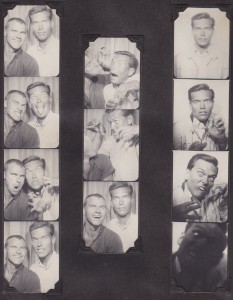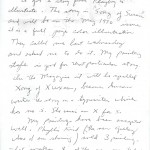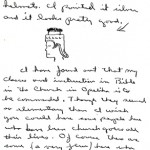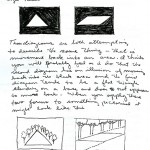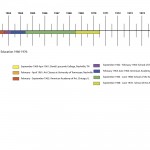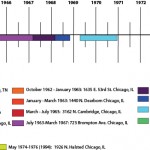Roger Brown’s Letters Home, 1960-1976
Wednesday, April 17th, 2013 » By James Connolly » See more posts from Blogging the Archive
Written by Laura Bickford
I spent the Fall semester of 2012 reading, sorting, and organizing a collection of photocopied letters that Roger Brown wrote home to his parents from 1960-1976. These were formative years for Brown, documenting his decision to leave the South and become an artist, his first impressions of Chicago, art school, his now-famous peers, and his initial thoughts about collecting and arranging objects in his home.
Not a lot is known about Brown’s life before he lived at 1926 N. Halsted and these letters offer some of the best clues of his developing worldview and evolving perspective on art-making as he found himself in a new, challenging, and inspiring city, both personally and artistically.
The original copies of these letters are in the collection of the Roger Brown Rock House Museum in Beulah, Alabama. Images in this blogpost are from the Rock House Museum collection.
During the period of 1960-1976, Brown left his parents’ home in Alabama for the first time to attend school at David Lipscomb College in Nashville, Tennessee. Sensing that the evangelical nature of the school was not conducive to the artistic life he envisioned, he spent some time taking art classes in Nashville and traveling through the South with a performer named Don. When he finally arrived in Chicago in 1960, staying first at a YMCA in Hyde Park, he wrote enthusiastic letters to his family detailing his new experiences, encounters, and impressions, both infectious and amusing. Particularly insightful, both to Brown as an artist and as a person, were his detailed descriptions of his lessons in art history and techniques. Before powering through his BFA in 1968 and his MFA in 1970, both at the School of the Art Institute of Chicago, he earned a certificate from the American Academy of Art and Design in commercial design. In one of the letters to his parents, he detailed an assignment involving repeatedly drawing straight lines for eight hours and his mastering of several typographies by free-hand. These early technical lessons, when considered with his job working at a decal company (and before that, counting steaks at his job as a maitre d’ at the Palmer House Hotel!), can be seen as clear milestones and important sources of influence in the later development of his exacting technique, both stylistically and philosophically. Additionally, the seriousness with which Brown relayed home his responses to his visits to the Art Institute, particularly to the work of Surrealist artists and pre-Raphaelite painters, and the detailed descriptions and diagrams he would include in his letters about his lessons on three-point perspective and his first appreciation of the diligence and creativity necessary to become an artist, were early evidence of his lifelong dedication to being a full-time, occupational artist who drew from the entire object landscape for inspiration.
After working at the Roger Brown Study Collection for three years and constantly being impressed by the continuity between Brown’s early observations and sketches, and his finished works and writing, reading these early letters home added a new appreciation to his foresight. His almost intuitive self-awareness of the gravity of events as they occurred, and the seeming recognition of the impact they would have on him later in life, is striking. In the letters, he would send accounts home to his parents about mundane events that we now know were pivotal in his career and the development of his artistic and philosophical sensibility. This ability to recognize important moments in his life as they happened to him lends a deeper layer of meaning for me, for the RBSC and the archival collections housed within it. The sorts of documents he saved, now in the archive, has always been surprising to me; even more shocking is when one of these seemingly random letters or scraps of paper reveals the answer to a question about one of his works of art or an object in the collection that had plagued us. Brown’s ability to see everything through a big-picture lens is evident in his works that are simultaneously deeply personal but enlighteningly universal. His awareness of the long-term importance to the School and future students of his house and collection at 1926, is an aspect of the Study Collection that is perhaps one of the most powerful lessons I will take with me. By keeping yourself constantly open to the possibility of having a life-changing experience at any moment allows for just such experiences to happen. Getting as close as possible to what moves you, whether objects, places, people, or thoughts, and allowing those things to change you without an awareness of in what way or for what purpose, is an important aspect of a life worth living.
It felt so fitting to end my time at the SAIC, the Study Collection, and perhaps Chicago, reading about Brown’s beginnings at the school, 1926, and this city, which he grew to love so much.
You can access a map showing all of Brown’s Chicago addresses during this time here. The map offers insight into the neighborhoods Brown was living in and reacting to as moved around the city.
Here are two timelines, one indicating the addresses he lived at in Chicago during this
time, and the other indicating the chronology of his education.

